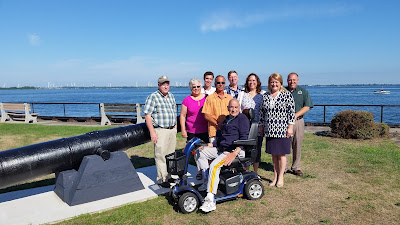Assemblywoman Addie Jenne Russell was in Cape Vincent when a cannon dating back to the 17th Century was unveiled at its new home at East End Park.
Th 6,000-pound cannon was recovered from the St. Lawrence River in the early 1960s and had spent most of the past two decades at the Canadian War Museum in Ottawa, Ont., on loan from the New York State Museum.
Assemblywoman Russell said the recovery of a then three century old cannon is yet another reminder of the region's strategic importance throughout history. The life of this 350-year-old cannon reads like a soap opera," she pointed out.
"It's important to remind people how important communities in the River District have been throughout our nation. We all recognize the beauty of our region, but we were also a strategic location in battles that helped shape our country," Assemblywoman Russell said.
"While we are no longer fighting wars on the shores of the St. Lawrence River, the river continues to be an important part of the world," she added.
The cannon and two others were reportedly sunk in the St. Lawrence River in the early 1800s amid hostilities that led to the War of the 1812.
The cannon is believed to have had a rich history before it was discovered off Carleton Island by divers in 1962.
Historians believe the cannon was cast in Britain circa 1650 and sent across the ocean to New York City aboard the HMS Vanguard in 1737.
It was moved to either Oswego or Fort William Henry during the French and Indian War and captured by the French in 1756-57. It was recaptured by the British just a few years later during the Battle of Isle Royal near Ogdensburg.
The cannon was then taken from the fort at Isle Royal to Fort Haldiman on Carleton Island, near Cape Vincent, during the Revolutionary War.
But concerns that the cannons could fall into the hands of the Americans led the British to drop three cannons to the bottom of the St. Lawrence River before the start of the War of 1812.
The cannon is now the property of the Sackets Harbor Battlefield State Historic Site on loan to the village of Cape Vincent. East End Park is on the shore of the St. Lawrence River and overlooks Carleton Island.
IN THE PHOTOS:
TOP PHOTO:
Assemblywoman Addie Jenne Russell was in Cape Vincent recently when a cannon, whose local history dates back to the War of 1812, was unveiled at its new home in the East End Park in Cape Vincent. Pictured are Dennis McCarthy, a historian who has done major research on the cannon; Cape Vincent Town Supervisor Deb Suller; Cape Vincent Chamber of Commerce member Mike Chavoustie; Cape Vincent Mayor Tim Maloney; former Thousand Islands Parks Regional Director Kevin Kieff; Thousand Islands Parks Regional Director Peyton Taylor; Assemblywoman Russell; and Thousand Island Parks Deputy Director Mike Spaulding.
BOTTOM PHOTO:
Assemblywoman Addie Jenne Russell (r) and Cape Vincent Town Supervisor Deb Suller read about the history of a British cannon dating back to the 17th Century that is now located in Cape Vincent's East End Park.
Assemblywoman Addie Jenne Russell visits with Kevin Kieff, who retired last year after a lengthy career as Thousand Islands regional director of the Office of Parks, Recreation and Historical Preservation. Mr. Kieff played a major role in bringing a cannon that has been housed at the Canadian War Museum for the past two decades, on loan from the New York State Museum, back to Cape Vincent.



